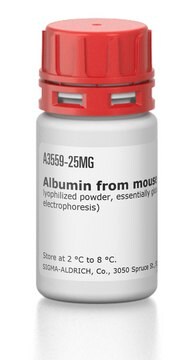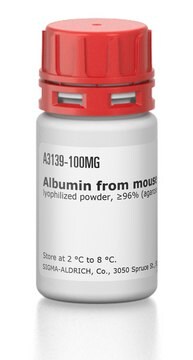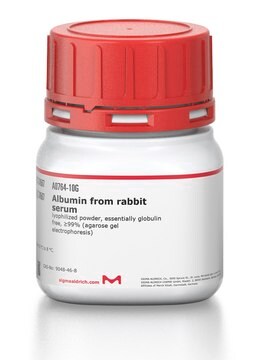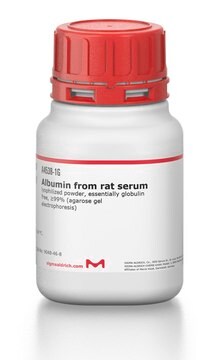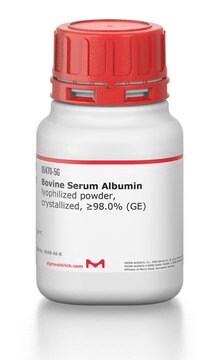A6272
Albumin from rat serum
lyophilized powder, ≥96% (agarose gel electrophoresis)
Synonim(y):
RSA, Rat albumin
About This Item
Polecane produkty
pochodzenie biologiczne
rat
Poziom jakości
Próba
≥96% (agarose gel electrophoresis)
Formularz
lyophilized powder
metody
ELISA: suitable
tissue culture: suitable
western blot: suitable
numer dostępu UniProt
temp. przechowywania
2-8°C
informacje o genach
rat ... ALB(24186)
Szukasz podobnych produktów? Odwiedź Przewodnik dotyczący porównywania produktów
Opis ogólny
Zastosowanie
- in sulfo-4-(N-maleimidomethyl)cyclohexane-1-carboxylic,acid 3-sulfo-N-hydroxy-succinimide ester sodium salt (SMCC) derivatization studies
- as a component of dispersion media for the suspension of multi-walled carbon nanotubes (MWCNTs)
- as a macromolecular probe in microvascular solute flux measurements
Działania biochem./fizjol.
Kod klasy składowania
11 - Combustible Solids
Klasa zagrożenia wodnego (WGK)
WGK 3
Temperatura zapłonu (°F)
Not applicable
Temperatura zapłonu (°C)
Not applicable
Środki ochrony indywidualnej
Eyeshields, Gloves, type N95 (US)
Wybierz jedną z najnowszych wersji:
Certyfikaty analizy (CoA)
Nie widzisz odpowiedniej wersji?
Jeśli potrzebujesz konkretnej wersji, możesz wyszukać konkretny certyfikat według numeru partii lub serii.
Masz już ten produkt?
Dokumenty związane z niedawno zakupionymi produktami zostały zamieszczone w Bibliotece dokumentów.
Klienci oglądali również te produkty
Nasz zespół naukowców ma doświadczenie we wszystkich obszarach badań, w tym w naukach przyrodniczych, materiałoznawstwie, syntezie chemicznej, chromatografii, analityce i wielu innych dziedzinach.
Skontaktuj się z zespołem ds. pomocy technicznej

